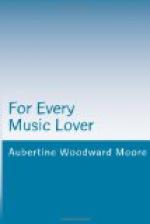"Let the barbarians praise
thee with the harp,
Let the British crwth sing."
This instrument, whose name signifies bulging box, was common in Britain, and was used in Wales until a comparatively recent period. One of its distinguishing features was an opening in the lower part for the admission of the fingers while playing. A fine specimen is preserved in the South Kensington Museum, corresponding well to the following description by a Welsh poet of the fifteenth century: “A fair coffer with a bow, a girdle, a finger-board and a bridge; its value is a pound; it has a frontlet formed like a wheel with the short-nosed bow across. In its centre are the circled sounding-holes, and the bulging of its back is somewhat like an old man, but on its breast harmony reigns, from the sycamore melodious music is obtained. Six pegs, if we screw them, will tighten all its chords; six advantageous strings are found, which, in a skilful hand, produce a varied sound.”
In this same museum is a curious wedge-shaped boxwood fiddle, decorated with allegorical scenes, and dated 1578. Dr. Burney states that it has no more tone than a violin with a sordine. It is said to have been presented by Queen Elizabeth to the Earl of Leicester, and bears both of their coats-of-arms in silver on the sounding-board. Besides her other accomplishments, the Virgin Queen, we are told, was a violinist. During her reign we find the violin mentioned among instruments accompanying the drama and various festivities, and viols of diverse kinds were freely used. Shakespeare, in Twelfth Night, has Sir Toby enumerate among Sir Andrew Aguecheek’s attractions skill on the viol-de-gamboys, Sir Toby’s blunder for the viola da gamba, a fashionable bass viol held between the knees. A part was written for this instrument in Bach’s St. Matthew Passion, and a number of celebrated performers on it are recorded in the eighteenth century. Two of these were ladies, Mrs. Sarah Ottey and Miss Ford.
Violers and fiddlers formed an essential part of the retinue of many monarchs in the sixteenth and seventeenth centuries. Charles II., of England, had twenty-four at his court, with red bonnets and flaunting livery, who played for him while he was dining according to the custom he had known at the French court during his exile. Place was grudgingly yielded to the violin by friends of the less insistent viol. Butler, in Hudibras, styled it “a squeaking engine.” Earlier writers mention “the scolding violin,” and describing the Maypole dance tell of not hearing the “minstrelsie for the fiddling.” Thus all along its course it has had its opponents and deriders as well as its friends.




